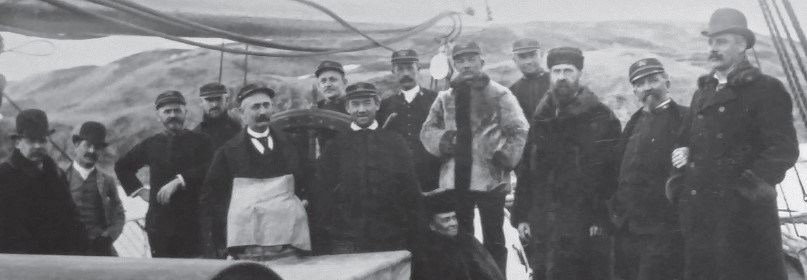Last updated: February 13, 2025
Article
Black History in the Last Frontier: Michael Healy

Copyright: University of Alaska Fairbanks, Alaska and Polar Regions Collections & Archives, Elmer E. Rasmuson Library. John Taylor White Photography Collection, Acc #76-2—225n.
Born in Georgia in 1839, the son of an Irish-born slaveholder and a black woman, Michael Healy grew up amid the tumult of sectional conflict and civil war. Though he was born enslaved, his mixed-race heritage provided him with opportunities that most black men in the South could never have imagined. His father, a wealthy plantation owner, sent Healy north to receive an education; that a white father would send a mixed-race son away for schooling was not unheard of in the antebellum era.
After the American Civil War, Healy and other formerly enslaved men faced limits to their advancement, and it remained nearly impossible for even Healy, despite his light skin, to become anyone other than a second-class citizen in much of the United States. Still, Healy’s skin tone and education allowed to him to pass as white in other parts of the country, namely the American West. Healy took advantage of an opportunity to serve in the US Revenue Cutter Service, the precursor to the Coast Guard and headed towards the Pacific Coast. While the Revenue Cutter Service prohibited African Americans from enlisting, Healy kept his African descent hidden and managed to ascend the ranks. Over the next thirty years, Healy developed as a skilled mariner and plied his trade in the choppy waters of the North Pacific.
Following the 1867 Treaty of Cession, the Revenue Cutter Service provided a key line of defense and maintained a presence along the Pacific Coast, from Oregon and Washington up to newly acquired territory of Alaska and into the waters of Bering Sea and the arctic. With over 20,000 miles of coastline, the Revenue Cutter Service patrolled an enormous expanse.
Educated Former Slave Joins US Revenue Cutter Service
After the American Civil War, Healy and other formerly enslaved men faced limits to their advancement, and it remained nearly impossible for even Healy, despite his light skin, to become anyone other than a second-class citizen in much of the United States. Still, Healy’s skin tone and education allowed to him to pass as white in other parts of the country, namely the American West. Healy took advantage of an opportunity to serve in the US Revenue Cutter Service, the precursor to the Coast Guard and headed towards the Pacific Coast. While the Revenue Cutter Service prohibited African Americans from enlisting, Healy kept his African descent hidden and managed to ascend the ranks. Over the next thirty years, Healy developed as a skilled mariner and plied his trade in the choppy waters of the North Pacific.Following the 1867 Treaty of Cession, the Revenue Cutter Service provided a key line of defense and maintained a presence along the Pacific Coast, from Oregon and Washington up to newly acquired territory of Alaska and into the waters of Bering Sea and the arctic. With over 20,000 miles of coastline, the Revenue Cutter Service patrolled an enormous expanse.

National Archives Photo, No. 026-G-60-16-(3)
From Skilled Navigator To Captain
In 1883, Healy became a captain and solidified his standing as one of the most skilled navigators of the North Pacific’s treacherous waters. As captain of the cutter Rush, Healy and his crew were a reliable presence along thousands of miles of coastal waters from San Francisco to Barrow, aiding distressed ships of whalers and commercial fishermen. In one instance, his crew aboard the cutter Bear conquered gale force winds off the coast of Point Barrow to save 160 men stranded at sea.Beyond patrolling the seas, Healy and Lieutenant George Stoney were the first non-Native men to map the Kobuk River and its attendant valleys. Healy also worked with Alaska Natives who lived along the Bering and Chukchi Seas. These communities relied on marine mammals for subsistence but were distrustful of the commercial whalers. Healy served as an arbiter between outsiders who hunted the bowheads for profit and indigenous people who required them for food.
Helping At Sea and On Shore
As whalers took more bowheads, Healy and the region’s Iñupiat explored reindeer herding as an alternative means of subsistence. By the 1890s, Alaska Native people, with help from men like Healy and missionaries such as Sheldon Jackson, increasingly looked to domesticated reindeer as a source of food.While Healy cultivated a relatively warm relationship with Alaska Natives, he had his detractors. In particular, Healy offended the sensibilities of the Women’s Christian Temperance Union (WCTU). The WCTU believed Healy had succumbed to his addictions of “demon rum,” corrupted the morals of young men, and was generally unfit for his job. Indeed, Healy handled his crew with harsh discipline, often fueled by alcohol-induced rage. His nickname “Hell Roaring Mike Healy,” suggested a man with a short temper. Nonetheless, few disputed his skills as a captain and his tenacity in the face of harsh conditions. At the peak of his career, Healy knew the expanse of the North Pacific and Arctic waters better than anyone. Perhaps most famously, Healy led the naturalist and cofounder of the Sierra Club, John Muir, to Alaska into what is today Glacier Bay National Park during the 1880s. These trips brought greater awareness of Alaska’s rugged beauty to the nation.
In honor of Healy’s accomplishments, the United States Coast Guard named an icebreaker (among the more technologically advanced ships in the fleet) the USCG Healy in 1999, ninety five years after his death.
